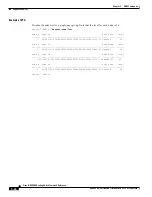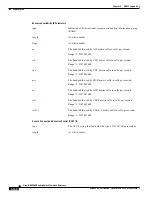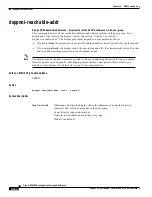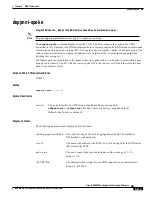
5-99
Cisco MGX 8850 Routing Switch Command Reference
Release 2.0, Part Number 78-10467-04 Rev C0, October 2001
Chapter 5
PNNI Commands
dsppnni-ptse
remote node id
The node ID of the remote node. For a description of the node ID,
see the description for addpnni-node or cnfpnni-node.
remote port id
The logical PNNI identifier on the remote interface. For more
details, see
PNNI Format
.
Range: 1–2147483648
local port id
The logical PNNI identifier on the local interface. For more details,
see
PNNI Format
.
Range: 1–2147483648
aggregation token
See the description of the cnfpnni-intf command for a definition of
an aggregation token. The current release does not support link
aggregation.
Range: 1–32
Uplink IG Parameters
Note
The current release does not support uplinks.
type
The ASCII string that indicates the type of up link IG parameters.
length
A 16-bit number.
flags
A string of 8-bit flags.
remote higher level node id
The PNNI node identifier assigned to a PNNI node.
common pg id
The peer group ID (of length level) that assigned to the PNNI
common PG. This peer group is the local peer group.
Default: Figure 5-1 shows the factory-set default.
local port id
The logical PNNI identifier on the interface. For more details, see
PNNI Format
.
Range: 1–2147483648
aggregation token
Range: 1–2147483648.
upnode ATM address
The ATM address of the PNNI uplink node. The upnode ATM
address is a 20-byte, hexadecimal string. The upnode is the node at
the other end of the uplink. It is the neighboring peer of the ancestor
of the node from which the uplink originates.
Default: none
















































